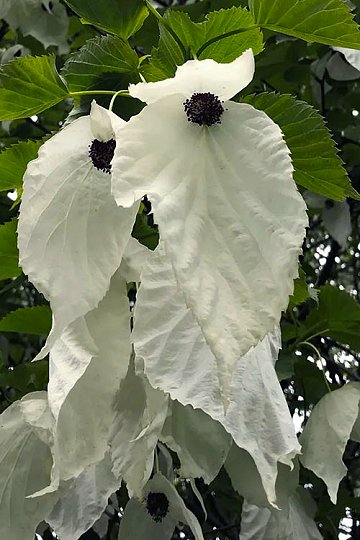
|
|
Dove Tree (Davidia involucrata). Leaves and
bracts.
|
Dove Tree - Davidia involucrata
Davidia involucrata, the dove tree, handkerchief tree, pocket handkerchief tree, or ghost tree, is a medium-sized deciduous tree in the family Nyssaceae. It is the only living species in the genus Davidia. It was previously included with tupelos in the dogwood family, Cornaceae. Fossil species are known extending into the Upper Cretaceous.
Davidia involucrata is the only member of its genus, but there are two varieties differing slightly in their leaves, D. involucrata var. involucrata, which has the leaves thinly pubescent (short-haired) on the underside, and D. involucrata var. vilmoriniana, with glabrous (hairless) leaves. Some botanists treat them as distinct species, with good reason, as the two taxa have differing chromosome numbers so are unable to produce fertile hybrid offspring.
Davidia involucrata is native to South West, South Central and Southeast China. It grows in montane mixed forests.
The genus Davidia is named for Father Armand David (1826–1900; "Père David"), a French Vincentian missionary and keen naturalist who lived in China. David first described the tree in 1869 as a single tree found at over 2,000 m altitude, in Tibet, and sent dried specimens to the Botanical Garden of Paris.; in 1871, Henri Baillon described it as a new genus and species.
British plant hunter Augustine Henry again found a single tree, this time in the Yangtse Ichang gorges and sent the first specimen to Kew Gardens. Plant collector Ernest Henry Wilson was employed by Sir Harry Veitch to find Henry's tree but arrived to find that it had been felled for building purposes; however, he later found a grove of the trees overhanging a sheer drop. Returning to Britain, Wilson’s boat was wrecked, but he managed to save his Davidia specimens, one of which survives today in the Arnold Arboretum.
Davidia involucrata is a moderately fast-growing, scented deciduous tree, growing to 20–25 m
in height, with toothed, alternate, ovate-cordate leaves resembling those of a linden, except that they are symmetrical, and lack the lop-sided base typical of linden
leaves.; They have a serrated leaf margin and are silky haired on the underside of the leaf. The petioles grow up to 7 cm
long and the leaves are mostly 10–20 cm long and 7–15 cm wide. The burgundy leaves turn light green as they mature. In autumn, the leaves turn yellowish-brown to bronze and then fall off.
In the early summer the tree produces white floral bracts which hang like a 'handkerchief' from the branches (in its native China the tree in known as the 'handkerchief tree' for this reason). The bracts flutter in the slightest breeze, and, from a distance, purportedly look like white doves sitting in the tree, hence the common
name (Dove tree).
At first, the bracts are coloured green, which enables them to photosynthesize. Later they turn white and thus attract pollinators.
The most important pollinators are pollen-collecting bees, which prefer to fly to the white, not the green bracts, according to a Chinese-German research group. The bracts also protect the flowers from heavy rain.
The white bracts surrounding a purplish-red flower head. The true flowers form a tight head about 1–2 cm across, each flower head.
The inflorescences hang in long rows beneath the horizontal branches, and appear prolifically in late spring.
When the flowers wither, the bracts take on a brownish colour. Flowers are followed by round, elliptical,
greenish-brown fruits. The fruit is a very hard nut about 3 cm long surrounded by a green husk about 4 cm long by 3 cm wide, hanging on a 10 cm stalk. The nut contains 3–6 seeds. The fruits usually remain on the tree longer than the falling leaves.
The overripe pear-shaped fruits are edible, though not recommended.
The ingredients of the tree have barely been researched so far, which is why we advise against consuming any parts of the plant. In 2016, Chinese researchers were able to detect, among other things, various alkaloids, flavonoids and tannins that can cause symptoms of poisoning when eaten raw – both in humans and animals.
Source:
https://en.wikipedia.org/wiki/Davidia_involucrata
https://hayloft.co.uk/davidia-involucrata-g-k32984
https://plantura.garden/uk/trees-shrubs/
handkerchief-tree/handkerchief-tree-overview
